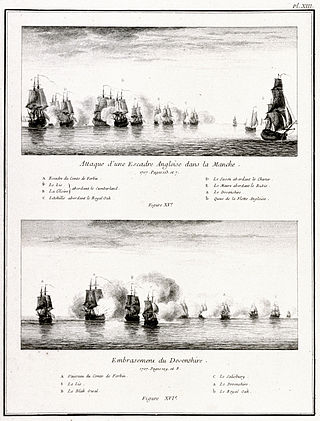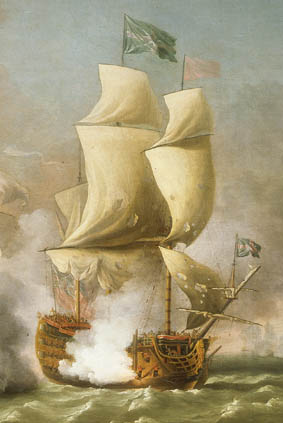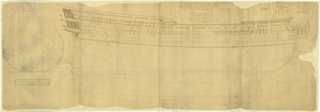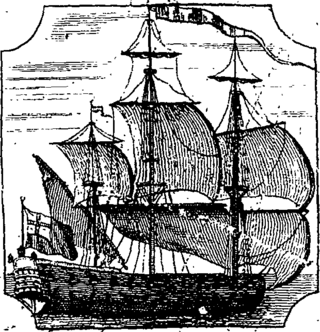
HMS Caledonia was a 120-gun first-rate ship of the line of the Royal Navy, launched on 25 June 1808 at Plymouth. She was Admiral Pellew's flagship in the Mediterranean.

HMS Northumberland was a 70-gun third-rate ship of the line of the Royal Navy, built at Deptford Dockyard and launched in 1705.

HMS Duke was a 90-gun second-rate ship of the line of the Royal Navy, launched on 13 June 1682 at Woolwich Dockyard.

HMS Atlas was a 98-gun second-rate ship of the line of the Royal Navy, launched on 13 February 1782. She was a Duke-class ship of the line built at Chatham Dockyard by Nicholas Phillips.

HMS Charles was a 96-gun first-rate ship of the line of the Royal Navy, built by Christopher Pett at Deptford Dockyard until his death in March 1668, then completed by Jonas Shish after being launched in the same month. Her name was formally Charles the Second, but she was known simply as Charles, particularly after 1673 when the contemporary Royal Charles was launched.

HMS Salisbury was a 50-gun fourth rate ship of the line of the Royal Navy, one of eight such ships authorised by the Navy Board on 24 December 1695 to be newly built ; the others were the Hampshire, Dartmouth, Winchester, Worcester, Jersey, Carlisle and Tilbury. The contract for the Winchester was signed with shipbuilders Richard and James Herring in 1696, for the ship to be built in their yard at Baileys Hard on the Beaulieu River in Hampshire, England, and she was launched there on 18 April 1698.

HMS Canterbury was a 60-gun fourth-rate ship of the line of the Royal Navy, launched at Deptford on 18 December 1693.

HMS Barfleur was a 90-gun second rate ship of the line of the Royal Navy, launched at Deptford Dockyard on 10 August 1697.

HMS Swiftsure was a 70-gun third-rate ship of the line of the Royal Navy, launched in 1755 and in active service during the Seven Years' War. After a distinguished career at sea she was decommissioned in 1763 and sold into private hands ten years later.

HMS Weymouth was a 50-gun fourth rate ship of the line of the Royal Navy, launched at Portsmouth Dockyard on 8 August 1693. She was one of two 50-gun ships ordered on 15 August 1690 to be built by Master Shipwright William Stigant at Portsmouth Dockyard. However, unlike the Norwich, the Weymouth was delayed until 1693 and - instead of the 123 ft length originally specified - was lengthened to 132 ft 4 in, thus becoming the prototype for the 1693 batch ordered with a design extended to some 130 ft.

HMS Dartmouth was a 50-gun fourth-rate ship of the line of the Royal Navy, one of eight such ships authorised by the Navy Board on 24 December 1695 to be newly built ; the others were the Hampshire, Winchester, Salisbury, Worcester, Jersey, Carlisle and Tilbury. The contract for the Dartmouth was signed in 1696 with shipbuilder James Parker, for the ship to be built in his site in Southampton, taking the name of the previous Dartmouth of 1693, and she was launched there on 3 March 1698.
HMS Winchester was a 50-gun fourth rate ship of the line of the Royal Navy, one of eight such ships authorised by the Navy Board to be newly built ; the others were the Hampshire, Dartmouth, Salisbury, Worcester, Jersey, Carlisle and Tilbury. The contract for the Winchester was signed with shipbuilders John and Richard Wells in 1696, for the ship to be built in their yard at Greenland North Dockyard, in Rotherhithe, and she was launched there on 17 March 1698.
HMS Worcester was a 50-gun fourth rate ship of the line of the Royal Navy, one of eight such ships authorised by the Navy Board on 24 December 1695 to be newly built ; the others were the Hampshire, Dartmouth, Salisbury, Winchester, Jersey, Carlisle and Tilbury. The contract for the Worcester was signed with shipbuilder Robert Winter on 26 February 1696, for the ship to be built in his yard at Northam in Southampton, and she was launched there on 31 May 1698.
HMS Rochester was a 50-gun fourth rate ship of the line of the Royal Navy, and the fifth such ship to be ordered in 1692. She was launched at Chatham Dockyard on 15 March 1693.

HMS Lichfield was a 50-gun fourth-rate ship of the line of the Royal Navy, one of five such ships authorised on 16 November 1693 (three to be built in different Royal Dockyards and two to be built by commercial contract. The Lichfield was built by Master Shipwright William Stigant at Portsmouth Dockyard and launched on 4 February 1695. She was first commissioned in that year under Captain Lord Archibald Hamilton, for service in Home Waters.

HMS Guernsey was a 50-gun fourth rate ship of the line of the Royal Navy, one of four ordered in September 1694 to be built by commercial contracts; eight further ships of this type were ordered on 24 December. The Guernsey was built by Sir Henry Johnson's Blackwall Yard and launched on 6 July 1696.
HMS Warwick was a 50-gun fourth rate ship of the line of the Royal Navy, one of four ordered in September 1694 to be built by commercial contracts; eight further ships of this type were ordered on 24 December. The Warwick was built by Robert and John Castle at their Deptford shipyard and launched on 20 August 1696.
HMS Falmouth was a 50-gun fourth-rate ship of the line built for the Royal Navy in the first decade of the 18th century. The ship participated in several battles during the War of the Spanish Succession (1701–15) and the War of Jenkins' Ear (1739–48).

HMS Gloucester was a 50-gun fourth-rate ship of the line built at Deptford by Joseph Allin the elder for the Royal Navy in 1710/11. She participated in the War of the Spanish Succession. The ship was burned to prevent capture after she was damaged in a storm during Commodore George Anson's voyage around the world in 1742.

HMS Gloucester was a 50-gun fourth rate ship of the line built for the Royal Navy in the 1740s. She participated in the 1740–48 War of the Austrian Succession, capturing four French privateers. The ship was broken up in 1764.














